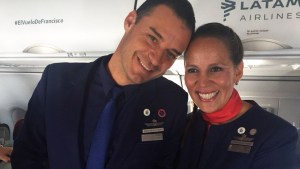To visit Indonesia, Papua New Guinea, East Timor, and Singapore, Pope Francis, age 87, spent 44 hours in the air.
A front row seat
When flying, Pope Francis habitually occupies the left front row of the aircraft, just behind the cockpit. The other passengers respect a certain hierarchy: the closer you are to the Pope, the more important you are. At the back of the aircraft are the journalists, separated from the papal area by drawn curtains.
For the media, the seat of Pope Francis becomes a kind of reference point which can be seen by poking one’s head into the corridor in order to see a piece of his white mozzetta sticking out, and sometimes even his matching zucchetto.
But, from the rear seats, we know little about what goes on in the front rows, or even what this compartment looks like, other than through some privileged testimonials or photos.

During this journey, a journalist from Timor, who was celebrating her birthday on the day of the flight to Singapore, was escorted to the front of the plane by the Holy See’s press room manager. Very moved, she didn’t pay attention to all the details, but did notice that the Pontiff had more legroom and that an icon of the Argentinian Virgin of Lujan had been set up, in front of which flowers had been laid.
Front row isn’t always first class
But does this mean the Pope flies first class? In fact, the Pope’s comfort varies according to the airline he travels with. On his journey from Rome to Jakarta, the Pope flew on an ITA Airways A330. According to a photo published by a passenger close to the Pope, the Jesuit Antonio Spadaro, this featured a real first-class seat and a large screen.
Still, comfort can vary from airline to airline. A stewardess from Garuda Indonesia told us that the Pope was “very comfortable” on his flight from Jakarta to Port Moresby. On the other hand, conditions on board the Australian Air Force C-130 that took charge of the tricky round-trip flight between Port Moresby and Vanimo, Papua New Guinea, were more rustic.

For flights operated by Air Niugini and Aero Dili, the airlines of Papua New Guinea and East Timor, the planes were more modest and the Pope had a much more “standard” seat. Journalists asked a lot of questions about how the Pope felt after a rather rough landing in Dili — but however he felt, it wasn’t notable enough to warrant a report to the journalists.
One very experienced journalist, who has been traveling with popes for over 30 years, said that Pope Francis tended to settle for a “small business class” rather than a first-class airplane seat. John Paul II, she assures us, “flew comfortably but without excess,” leaving an empty seat next to him.
Lastly, Benedict XVI, “who did not like traveling at all,” is said to have traveled in particularly comfortable conditions, although this did not enable him to overcome the serious sleep problems that such travel entailed for him.



